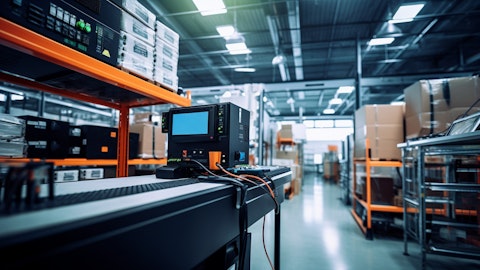TPI Composites, Inc. (NASDAQ:TPIC) Q1 2025 Earnings Call Transcript May 12, 2025
TPI Composites, Inc. misses on earnings expectations. Reported EPS is $-1.01 EPS, expectations were $-0.5.
Operator: Greetings and welcome to the TPI Composites First Quarter 2025 Earnings Call. [Operator Instructions] As a reminder, this conference is being recorded. It is now my pleasure to introduce Jason Wegmann, Vice President, Investor Relations and Sustainability. Please go ahead.
Jason Wegmann: Thank you, operator. I would like to welcome everyone to TPI Composites first quarter 2025 earnings call. We will be making forward-looking statements during this call that are subject to risks and uncertainties which could cause actual results to differ materially. A detailed discussion of applicable risks is included in our latest reports and filings with the Securities and Exchange Commission, which can be found on our website, tpicomposites.com. Today’s presentation will include references to non-GAAP financial measures. You should refer to the information contained in the slides accompanying today’s presentation for definitional information and reconciliations of historical non-GAAP measures to the comparable GAAP financial measures. With that, let me turn the call over to Bill Siwek, TPI Composites’ President and CEO.
Bill Siwek: Thanks, Jason. Good afternoon, everyone, and thank you for joining our call. In addition to Jason, I am here with Ryan Miller, our CFO. Please turn to Slide 5. I am pleased to report a solid start to the year with Q1 revenue up 14% year-over-year, positive cash flows of $4.6 million provided by operating activities, and we ended the quarter with $172 million of cash. 2024 included a significant number of line start-ups and transitions with 10 lines reaching serial production and several facilities in Mexico moving to 24/7 operations. As we exit the first quarter, all the line start-ups and transitions that began in 2024 are completed, we have substantially completed 4 lines that transitioned in the first quarter of this year and are well into the hiring at our Newton, Iowa plant where we are starting production this week.
Our focus now is on leveraging the investments made over the last year by utilizing lean tools to foster a culture of operational excellence. This drive aims to deliver repeatable world-class quality and delivery performance while achieving cost savings throughout the organization. As mentioned in previous quarters, customer demand continues to be strong for our Mexico operations capacity for 2025, and we are acutely focused on delivering on the commitments made to our customers. Sales for the quarter were $336.2 million and were in line with our expectations. The increase in sales of 14% over the prior year is primarily related to strong demand in the U.S. and the fact that we worked through a number of line transitions from 2024 that are now in serial production.
Adjusted EBITDA was a loss of $10.3 million, but included a $12.7 million warranty charge, $8.4 million of start-up and transition costs from 6 lines in start-up and transition and $4 million in costs to transition certain of our Mexico factories to the 24/7 shift structure. Our adjusted EBITDA margin benefited from strong sales into the U.S. in the quarter, partially offset by weaker sales coming out of our Türkiye factories. As previously disclosed in December 2024, we committed to a restructuring plan in Türkiye to rationalize our workforce in response to lower forecasted demand amid intense Chinese competition and the continued hyperinflationary environment. This restructuring plan impacted approximately 20% of our Turkish workforce. Looking forward, we expect we will further rationalize our workforce during the second half of 2025 as we have extensions for just two manufacturing lines beyond 2025 at this time.
And although there continues to be interest in our manufacturing capacity, it is unclear when or if that interest will ultimately result in firm contracts. Please turn to Slide 6. With respect to the wind market, the world is experiencing unprecedented energy demand by factors like the reshoring of manufacturing, industrial, electrification and a focus on national security. This demand is being further intensified by the rapid growth of data centers. In the United States, demand is expected to surpass 450 gigawatts by 2030, requiring a balanced and practical energy strategy. We believe this strategy should embrace all available energy solutions, recognizing the immediate and accelerating need for power. It must also be acknowledged that different energy technologies have varying levels of current readiness and cost implications.
Today, renewable energy and battery storage are the most affordable power sources and can be deployed rapidly unlike technologies like new natural gas plants and nuclear energy which face increasing costs and likely cannot be deployed in time to address energy demands that are here today. Consequently, we believe a comprehensive energy policy focusing on an all-of-the-above approach is crucial to effectively meet the substantial demand while considering the timely availability and affordability of each energy option. As a trusted and key supplier of wind blades for the leading Western turbine OEMs, we remain a critical cog of the wind industry supply chain. The relationships we have developed with these OEMs and our strategic footprints in low-cost locations have positioned us well for their blade needs.
While our supported markets are currently complex, their long-term prospects remain positive. It is crucial, however, to discuss the potential impacts on our business stemming from uncertainty around tariffs, permitting and possible changes to the IRA in the U.S. Concerning tariffs. As you know, we operate 8 plants across four countries. While completed blade sales from all plants into the U.S. are potentially subject to U.S. tariffs, assessing the impact requires a country-by-country analysis. Our Mexico plants almost exclusively support the U.S. market as will our Iowa facility. Importantly, under current regulations, all blades produced in our Mexico plants are USMCA compliant and therefore, exempt from tariffs. In Europe, our Türkiye plants primarily serve the EU and Türkiye with a small fraction of blades destined for the U.S. Our India plant supplies blades to the U.S., Asia, South America and Africa, with approximately 40% of its production shipped to the U.S. during the first quarter.
Blades sold into the U.S. out of our plants in India and Türkiye are subject to the existing tariff structures for those countries. However, our current contractual agreements with OEMs we serve stipulate that the OEMs bear the responsibility for these tariffs. Our supply chain is also experiencing the effects of U.S. tariffs. Years of developing strong strategic partnerships and redundancy within our supply base provide us with some flexibility to mitigate long-term cost impacts. The cost of blades produced at our Newton facility will likely be affected, though the final impact is still being assessed as we continue to develop mitigation strategies. It’s important to remember that Newton is in the start-up phase with minimal production expected in 2025.
As for the IRA, the final content of a budget reconciliation bill and timing remain uncertain, while reshoring manufacturing and creating associated U.S. jobs are critical priorities for this U.S. administration. Given the significant impact on jobs and investment in the U.S., we currently believe a full repeal seems unlikely. However, we expect concessions will likely have to be made to align with the administration’s spending priorities. The reopening of TPI’s Newton, Iowa facility is evidence of an IRA driven job creation. In collaboration with GE Vernova, we plan to have 2 production lines operational this year, providing approximately 400 good paying jobs. At full capacity, this facility can operate 5 lines and employ around 1,000 people.
The EU market presents a significant long-term growth opportunity, though considerable challenges persist in the current environment, including strong competition from Chinese manufacturers and the ongoing impact of hyperinflation at Türkiye, which posed continued risks for TPI. Positively, the EU’s permitting reforms, notably the renewable energy directive have provided for streamlined processes and prioritized renewables leading to faster project approvals as demonstrated by the wind energy market in Germany, where supportive legal frameworks recognized wind energy’s overriding public interest. While the EU’s permitting reforms and initiatives like the Net Zero industrial act auction resilience guidelines are encouraging steps, their slow adoption and inconsistent implementation across member countries remain impediments to the broader wind industry, creating uncertainty about their short-term impact on TPI.
Overall, the various economic challenges presented in the markets where we operate, as discussed above, continue to create uncertainty in the industry’s near-term outlook and continue to challenge our operations. In the near term, we are continuing to focus on maximizing value and ensuring we have sufficient liquidity to operate. On May 8, 2025, our Board of Directors formed a committee to, among other things, assist with conducting a strategic review of our business and evaluation of potential strategic alternatives focused on optimizing our capital structure for the current environment. To assist in leading the strategic review, we appointed two new independent directors to our Board, Tim Pohl and Neal Goldman. Both Tim and Neal have significant experience as strategic advisers and representing companies in strategic planning, negotiating complex transactions, M&A, capital raising, valuation, corporate governance and liability management.

With their assistance, we are in the process of assessing approaches to enhance our capital structure while maintaining sufficient liquidity. No timetable has been established for the conclusion of this review and no decisions related to any further actions or potential strategic alternatives have been made at this time. In addition, as reported in a Form 8-K on May 8, on May 2, 2025, the company received a notification letter from NASDAQ notifying the company that it is not in compliance with the minimum bid price requirement for continued listing on NASDAQ. The notification letter does not impact the company’s listing on NASDAQ at this time as we have 180 calendar days or until October 29, 2025, to regain compliance with NASDAQ’s listing rules.
To regain compliance, the bid price of the company’s common stock must have a closing bid price of at least $1 per share for a minimum of 10 consecutive business days. We intend to consider all available options to regain compliance with the minimum bid price requirement, including in connection with the ongoing review of strategic alternatives, I previously mentioned. With that, I’ll turn the call over to Ryan to review our financial results.
Ryan Miller: Thanks, Bill. Please turn to Slide 8. In the first quarter of 2025, net sales were $336.2 million compared to $294 million for the same period in 2024, an increase of 14.3%. Net sales of wind blades, tooling and other wind-related sales increased by $40.1 million or 13.9% to $329 million for the 3 months ended March 31, 2025, as compared to $288.9 million in the same period in 2024. This increase was primarily due to higher average sales prices due to changes in the mix of wind blade models produced and a 4% increase in the number of wind blades produced. The increase in volume was primarily due to the restart of production at 1 of our previously idled facilities in Juarez, Mexico and higher utilization as several of our manufacturing lines in Mexico and Türkiye are in serial production in the current period that were either in start-up or transition during the prior comparative period.
The increase in wind sales was partially offset by volume declines based on market activity levels impacting our Türkiye facilities and volume declines related to the Nordex Matamoros facility that shut down at the conclusion of the contract on June 30, 2024. Fuel service inspection and repair services sales increased $2 million or 38.4% to $7.1 million for the 3 months ended March 31, 2025, as compared to $5.1 million in the same period in 2024. The increase was primarily due to the increase in technicians deployed to revenue-generating projects due to a decrease in time spent on non-revenue-generating inspection and repair activities. Adjusted EBITDA was a loss of $10.3 million for the 3 months ended March 31, 2025, as compared to adjusted EBITDA loss of $23 million during the same period in 2024.
Adjusted EBITDA margin was a loss of 3.1% as compared to an adjusted EBITDA margin loss of 7.8% during the same period in 2024. The improvement was primarily due to the absence of losses from the Nordex Matamoros facility, which was shut down at the end of the second quarter in 2024, increased volume in our other Mexico locations, lower start-up and transition costs and cost savings initiatives. These improvements were partially offset by higher pre-existing warranty charges, higher labor costs in Türkiye and Mexico and 24/7 ship ramp-up costs in a number of our Mexico factories. Moving to Slide 9. We ended the quarter with $172 million of unrestricted cash and cash equivalents and $616 million of total debt. Free cash flow was negative $1.9 million in the first quarter of 2025 compared to negative free cash flow of $47.3 million in the same period in 2024.
The net use of cash in the first quarter of 2025 was primarily due to interest payments, tax payments and capital expenditures, slightly outpacing cash earnings and working capital improvements. Note that we had positive cash flow priority by operating activities in the quarter of $4.6 million. A summary of our financial guidance for 2025 can be found on Slide 10. We continue to anticipate sales from continuing operations in the range of $1.4 billion to $1.5 billion, representing high single-digit year-over-year growth at the midpoint of the guidance. This projected growth is primarily driven by increased blade shipments from our Mexico facilities to support the U.S. market and the planned reopening of our Iowa site, partially offset by projected reduced sales from our Türkiye and India facilities driven primarily by anticipated lower demand from our Nordex lines.
We have 6 lines in start-up and transition in 2025, including the 2 new lines reopening at our Iowa plant. We expect average selling prices to remain relatively flat year-over-year. Field Services revenue is expected to increase more than 50%, driven by a shift of technicians back to historical levels of revenue-generating activity. We expect adjusted EBITDA margin from continuing operations to be in the range of 0% to 2%, which has been revised from our previous guidance of 2% to 4%. The downward revision is primarily due to the warranty charge we recorded in the first quarter and the impact of a production suspension we experienced during April, because of a safety stand down put in place following an accident in one of our factories. 2025 utilization is expected to be in the range of 80% to 85% on 34 lines in production.
And finally, we expect capital expenditures of about $25 million to $30 million in 2025. With that, I’ll turn the call back over to Bill.
Bill Siwek: Thanks, Ryan. Please turn to Slide 12. Before we close our prepared remarks, I’m pleased to announce the publication of our 2024 sustainability report in March of this year. We remain committed to our publicly stated goals of fostering a zero-harm culture and achieving carbon neutrality by 2030 and through 100% renewable energy procurement. Wind blades produced by us in 2024 are estimated to prevent approximately 264 million metric tons of CO2 emissions over their 20-year lifespan. We are progressing towards our 2030 carbon neutrality goal having achieved a 17% reduction in overall market-based Scope 1 and 2 CO2 emissions. In Türkiye, one-third of our site’s electricity was generated from renewable energy and in India one quarter.
For our sites in Mexico, we signed power purchase agreement to ensure all our sites are powered by 100% renewable energy by the end of 2025 and we achieved our 5% reduction goal in production waste and continue to foster a culture of safety. We continue to partner with our OEMs to share best practices aimed at Scope 1 reductions. Furthermore, we are working to expand our PPA in India and exploring clean energy options for our Newton, Iowa facility. These investments not only provide environmental benefits, but also make strong economic sense directly contributing to improved financial performance. Please turn to Slide 14. In closing, it’s been a challenging environment, and we have a lot in front of us as we evaluate our strategic alternatives.
I am proud of how our team has managed through some challenging startups and transitions and driven operational improvements across the company. While we acknowledge the complexities and uncertainties within the global wind market, including policy considerations in the U.S. and macroeconomic factors in Europe and in Türkiye, our underlying fundamentals remain strong. We believe our focus on operational excellence and strategic partnerships positions us well to navigate these challenges and capitalize on the long-term opportunities within the renewable energy sector. We look forward to providing further updates on our progress throughout the year. Before we open the call for Q&A, I want to once again extend my gratitude to all our TPI associates for their continued commitment and dedication to TPI and our mission to safely decarbonize and electrify the world.
I will now turn it back to the operator to open the call for questions.
Q&A Session
Follow Tpi Composites Inc (NASDAQ:TPIC)
Follow Tpi Composites Inc (NASDAQ:TPIC)
Receive real-time insider trading and news alerts
Operator: [Operator Instructions] Our first question is from Mark Strouse with JPMorgan.
Mark Strouse: Good afternoon guys. Thank you very much for taking our questions. So, I just wanted to clarify, first of all, on the strategic review. So, Ryan, I have heard you say a few times in the past kind of evaluating kind of optimal capital structure. So, can you just kind of talk about kind of the nuances of what exactly is different with the strategic review versus what has been going on in the last few quarters? Thank you.
Bill Siwek: Yes. Hey Mark, it’s Bill. We are – we have been evaluating our capital structure and looking at alternatives. It’s just turned into a more formal process. That’s really the only difference. We are looking at how do we restructure our balance sheet. It’s really a right side of the balance sheet challenge, as you know, how do we right size our balance sheet for the near-term and then for the long-term health of the entity.
Mark Strouse: Okay. Alright. That makes sense. Thanks Bill And then I fully appreciate that it’s probably too early for you guys to give a fully robust view on this. But I did want to get kind of your initial views anyway on the house reconciliation language that just came out 1.5 hours or so before your press release? Thank you.
Bill Siwek: Yes. So, it’s still a little bit fresh. I think on 45Y, the phase, I think most were expecting some sort of a phase out, I think the challenge there is the completion placed into service versus start of construction, which is a bit different. And could pose some challenges there. I think on 45X, a little bit surprised that wind is getting treated differently than other technologies with an end date of 2027. So, obviously, that’s something that we heard rumors of that last week, but a little disappointed to see that. And I think on transferability, which is another key component of the IRA. It’s a little unclear still. I didn’t get all the way through that section of the bill, but we will be doing a little bit more work on that this evening to see how that might impact it.
Mark Strouse: Yes. That makes sense. Okay. Very helpful. I will take the rest offline. Thank you.
Bill Siwek: Thanks Mark.
Operator: Our next question is from Eric Stine with Craig-Hallum Capital.
Unidentified Analyst: Hey. This is Luke on for Eric. Appreciate you taking our questions. So, first year on the Iowa restart, obviously, on track here with production starting next week. Have you seen anything out there in the market in terms of demand that would make you consider potentially bringing on more lines there in the near future for 2026?
Bill Siwek: We have had discussions about – we do have capacity for up to five lines. We have had ongoing discussions with our customer there. But again, I think that will just depend on how demand develops and how reconciliation turns out, quite frankly, and tariff situation. But it’s a little bit early to tell, but we do – we have had discussions, and we would certainly like to light up more lines there, if we can.
Unidentified Analyst: Of course, makes a ton of sense. So, secondly here, you talked a few quarters back about identifying some potential supply chain cost reductions. I think the number you threw around was maybe 8% year-over-year in 2025. I mean given we have had a ton of market uncertainty since then with both tariffs and the IRA, how has this view really evolved for you, would you consider that to still be roughly a realistic target, or should we be thinking about that differently?
Bill Siwek: No. I think we are on target for the most part with all of those cost reductions as it relates to the supply chain specifically. That’s primarily just for the BOM, the bill of material. Depending on where tariffs end up and it’s – obviously it changed last night from China. There could be a small impact on our bill of material in Iowa based on where those – it will be much smaller now given the change in the tariff rate, at least for 90 days. But the number we gave before is we are right on track with that, if not a little bit better, and the market’s been cooperating. So, we are still on track.
Unidentified Analyst: Great. Very helpful. I will turn it over to you. Thanks.
Bill Siwek: Thanks.
Operator: Our next question is from Justin Clare with ROTH Capital Partners.
Justin Clare: Hey guys. Thanks for taking the questions here. I just wanted to follow-up on the 45X as you mentioned in the draft bill from the house here. The 45X could be phased down earlier than we would have anticipated, so by year end ‘27, if that change does actually make it through to the final bill, how might that affect your decisions to either add lines in Iowa or I know you are potentially considering another site where you could expand manufacturing. So, maybe just – I know it’s very early here, it just came out, but speak to how you might think about it.
Bill Siwek: Yes. It could – again, it really will depend on demand dynamics over the next couple of years, but that could certainly impact it. And as far as for another site, again, if 45X stays where it’s at, that could impact whether or not it’s feasible to open another site as well.
Justin Clare: Alright. Okay. That makes sense. And then just on tariffs I think – well, I guess first, you had previously talked about your customers wanting basically everything that you can produce for the U.S. market in 2025. Wondering if the tariffs have affected that or permitting issues or if that’s still the case? And then maybe if you could just speak to what you are seeing in terms of things shaping up for 2026. And specifically for the U.S. market?
Bill Siwek: Yes. For 2025, no change in what the demand profile is for our plants, providing blades for the U.S. market. And for 2026, it’s a little bit early still and with some of the uncertainty that we are all very well aware of. Right now, it looks like I would expect the U.S. market from our – at least demand from our perspective to be flat with 2025 at this point, so not a dip, but likely to be flat in 2026 as we see it today.
Justin Clare: Got it. Okay. And then just one more – you had mentioned, I think it was an incident in Q2 that might affect your EBITDA margins. So, just wondering if you could speak to how you see the EBITDA margins trending through the year? Do we get a dip or kind of flat with Q1 and Q2 and then increase in Q3, Q4? And maybe if you could just speak to, if you can, where you think EBITDA margins might be, like what the run rate could be heading into 2026?
Ryan Miller: Hey Justin, at Q1, we did have the warranty charge that impacted our EBITDA margin. So, excluding that, I am expecting our Q2 to probably be a little bit higher volume than we had, but we are dealing with an accident that we had with the safety stand-down. The impact to that is, we are expecting right now to be about probably $35-ish million of sales for the quarter. We will recover some of that throughout the balance of the year, but some of that will probably impact our full year. I still believe our full year sales guidance is at $1.45 billion. Still believe we can achieve that. From a margin perspective for the second half and our run rate going into 2016, do expect more healthy margins. So, volume will be – our third quarter will probably be our highest volume quarter, it will also be a quarter in which our margins should peak for the year.
Our kind of seasonally the fourth quarter, we tend to come down a little bit, but still have – should have a pretty strong second half in comparison to the first. Again, that first quarter impacted by the warranty charge and the second quarter impacted by the safety stand-down that we had.
Justin Clare: Okay. Very helpful. Thank you.
Operator: Thank you. There are no further questions at this time. I would like to hand the floor back over to Bill Siwek for any closing comments.
Bill Siwek: Thank you again for your time today and continued interest and support of TPI. I look forward to keeping you up-to-date on our progress throughout the quarter. Thank you.
Operator: This concludes today’s conference. You may disconnect your lines at this time. Thank you for your participation.
Follow Tpi Composites Inc (NASDAQ:TPIC)
Follow Tpi Composites Inc (NASDAQ:TPIC)
Receive real-time insider trading and news alerts





